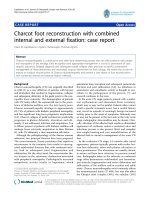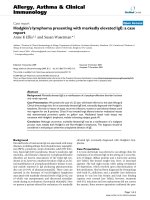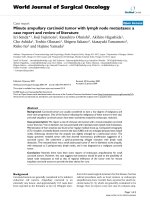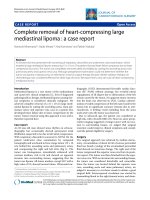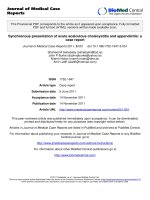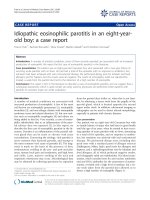báo cáo khoa học: "Synchronous presentation of acute acalculous cholecystitis and appendicitis: a case report" pot
Bạn đang xem bản rút gọn của tài liệu. Xem và tải ngay bản đầy đủ của tài liệu tại đây (2.11 MB, 9 trang )
This Provisional PDF corresponds to the article as it appeared upon acceptance. Fully formatted
PDF and full text (HTML) versions will be made available soon.
Synchronous presentation of acute acalculous cholecystitis and appendicitis: a
case report
Journal of Medical Case Reports 2011, 5:551 doi:10.1186/1752-1947-5-551
Shaheel M Sahebally ()
John P Burke ()
Niamh Nolan ()
Amir Latiff ()
ISSN 1752-1947
Article type Case report
Submission date 9 June 2011
Acceptance date 14 November 2011
Publication date 14 November 2011
Article URL />This peer-reviewed article was published immediately upon acceptance. It can be downloaded,
printed and distributed freely for any purposes (see copyright notice below).
Articles in Journal of Medical Case Reports are listed in PubMed and archived at PubMed Central.
For information about publishing your research in Journal of Medical Case Reports or any BioMed
Central journal, go to
/>For information about other BioMed Central publications go to
/>Journal of Medical Case
Reports
© 2011 Sahebally et al. ; licensee BioMed Central Ltd.
This is an open access article distributed under the terms of the Creative Commons Attribution License ( />which permits unrestricted use, distribution, and reproduction in any medium, provided the original work is properly cited.
Synchronous presentation of acute acalculous cholecystitis and appendicitis:
a case report
Shaheel M Sahebally
1
, John P Burke
1
*, Niamh Nolan
2
, Amir Latif
1
1
Department of General Surgery, St Columcille's Hospital, Loughlinstown, County
Dublin, Ireland
2
Department of Histopathology, St Columcille's Hospital, Loughlinstown, County
Dublin, Ireland
SMS:
JPB:
NN:
AL:
Abstract
Introduction: Acute acalculous cholecystitis is traditionally associated with elderly or
critically ill patients.
Case presentation: We present the case of an otherwise healthy 23-year-old
Caucasian man who presented with acute right-sided abdominal pain. An ultrasound
examination revealed evidence of acute acalculous cholecystitis. A laparoscopy was
undertaken and the dual pathologies of acute acalculous cholecystitis and acute
appendicitis were discovered and a laparoscopic cholecystectomy and
appendectomy were performed.
Conclusion: Acute acalculous cholecystitis is a rare clinical entity in young, healthy
patients and this report describes the unusual association of acute acalculous
cholecystitis and appendicitis. A single stage combined laparoscopic appendectomy
and cholecystectomy is an effective treatment modality.
Introduction
Acute acalculous cholecystitis (AAC) is rare clinical entity traditionally associated
with elderly patients with extensive co-morbidities or critically ill patients, such as
those with burns or who have sustained trauma. We present a case of an otherwise
healthy 23-year-old man who presented with acute right sided abdominal pain and
had ultrasonographic evidence of both AAC and acute appendicitis.
Case presentation
A 23-year-old unemployed Caucasian man presented to our Emergency Department
with a twelve-hour history of severe right upper and lower quadrant pain. This pain
originated in his epigastrium and was associated with nausea, multiple episodes of
non-bilious vomiting and anorexia. His background history was unremarkable. He
was on no regular medications, did not smoke and was a social drinker. On physical
examination, he had a normal pulse and blood pressure but was pyrexic (38.5°C). An
abdominal examination revealed tenderness in his right upper quadrant and right
iliac fossa, guarding and rebound tenderness. Rovsing, obturator and psoas signs
were negative. Laboratory investigations revealed an elevated white cell count of
14.3×10
9
/L, and slightly deranged liver function tests, namely a total bilirubin of
54µmol/L and aspartate aminotransferase of 39U/L with normal renal function and
electrolytes. A dipstick of his urine showed 1+ bilirubin, 1+ blood and 4+ ketones. His
Alvarado score was 10, consistent with appendicitis [1].
An ultrasound of his abdomen and pelvis revealed an inflamed, thick-walled
gallbladder but no evidence of gallstones (Figure 1A). His appendix could not be
visualised and there was no free fluid in the pelvis (Figure 1B). A diagnostic
laparoscopy was performed, which revealed a gangrenous gallbladder with omental
wrapping (Figure 1C) and an acutely inflamed appendix with thickened mesentery
(Figure 1D). A combined laparoscopic cholecystectomy and appendectomy was
performed. Histological examination of the resected gallbladder and appendix
showed acute cholecystitis with diffuse inflammation of the gallbladder wall, edema
and necrosis with extensive venous thrombi but no evidence of gallstones (Figure
1E) along with acute appendicitis (Figure 1F). Microbiological culture of the
gallbladder bile revealed no bacterial growth. Our patient's postoperative course was
unremarkable and he was discharged home two days later. At the latest follow-up,
four months after surgery, he is well and without complaint.
Discussion
AAC is a well-recognized but poorly understood clinical entity. Traditionally, it occurs
in elderly patients with chronic debilitating disease or patients with critical illness,
typically trauma or major burn injury. Whilst early case series associated AAC
exclusively with critical illness [2], more recent reports demonstrate increasing de
novo presentation of AAC in the absence of acute illness [3] and even in young,
otherwise healthy patients without any predisposing factors [4]. The age of onset of
AAC has been reported to be most commonly in the sixth decade [3]. The
commonest postulated etiologies of AAC are bile stasis resulting in a change in bile
composition, sepsis and ischemia [5]. In critically ill patients, AAC results from
gallbladder ischemia, which may be secondary to shock due to hypovolemia or
sepsis.
It has previously been noted that a hyperbilirubinemia occurs in acute appendicitis
[6]. It has been proposed that appendicitis associated hyperbilirubinemia is due to
bacterial translocation into the portal venous system, leading to altered bilirubin
excretion. This, in combination with sepsis, may have precipitated AAC in our patient.
Conclusion
AAC is a rare clinical entity in young, healthy patients and to the best of our
knowledge, this represents the first report of AAC associated with acute appendicitis.
A single stage combined laparoscopic appendectomy and cholecystectomy was an
effective treatment modality in this case, although the timing of surgery for acute
cholecystitis remains controversial, with some surgeons opting for interval
cholecystectomy which carries a lesser risk of conversion to an open procedure or
damage to the common bile duct, whereas other surgeons prefer early
cholecystectomy to avoid failure of conservative management and to prevent
disease recurrence. Surgical management of AAC in the end depends on the
severity of the disease, physical status of the patient and the laparoscopic skill of the
surgeon.
Consent
Written informed consent was obtained from the patient for the publication of this
case report and accompanying images. A copy of the written consent is available for
review by the Editor-in-Chief of this journal.
Competing interests
The authors declare that they have no competing interests.
Authors’ contributions
SS compiled and analyzed the patient’s data and wrote the initial draft. JPB
corrected the draft and assisted in the patient’s operation. NN performed the
histological examination of the resected gallbladder and appendix and contributed to
writing the manuscript. AL performed the operation and reviewed the final
manuscript. All authors read and approved the final manuscript.
References
1. Alvarado A: A practical score for the early diagnosis of acute appendicitis.
Ann Emerg Med 1986, 15(5):557-564.
2. Fox MS, Wilk PJ, Weissmann HS, Freeman LM, Gliedman ML: Acute
acalculous cholecystitis. Surg Gynecol Obstet 1984,159(1):13-16.
3. Savoca PE, Longo WE, Zucker KA, McMillen MM, Modlin IM: The increasing
prevalence of acalculous cholecystitis in outpatients. Results of a 7-year
study. Ann Surg 1990, 211(4):433-437.
4. Parithivel VS, Gerst PH, Banerjee S, Parikh V, Albu E: Acute acalculous
cholecystitis in young patients without predisposing factors. Am Surg 1999,
65(4):366-368.
5. Huffman JL, Schenker S: Acute acalculous cholecystitis: a review. Clin
Gastroenterol Hepatol 2010, 8(1):15-22.
6. Estrada JJ, Petrosyan M, Barnhart J, Tao M, Sohn H, Towfigh S, Mason RJ:
Hyperbilirubinemia in appendicitis: a new predictor of perforation. J
Gastrointest Surg 2007, 11(6):714-718.
Figure legend
Figure 1. Diagnostic, intra-operative and histological images. Ultrasound images
of (A) his gallbladder showing a thickened wall but no gallstones and (B) of his right
iliac fossa, without evidence of free fluid and without visualization of his appendix.
Intra-operative laparoscopy images demonstrating (C) a necrotic gallbladder and (D)
acute appendicitis. Histological images demonstrating (E) gallbladder mucosa with
acute inflammation with necrosis of the mucosa and submucosal thrombi and (F)
acute appendicitis.


